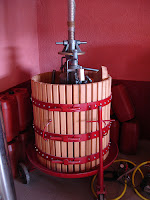
I've
posted before about neural marketing and the online buzz machinery. Part of the process of building a "Borat Buzz" around the Bijou property has been a couple of Google AdWords campaigns we're running. For the crew of producers, myself included, this is a new experience.
Of course we'd been reading about the new marketing communications paradigm, and the price of Google's common stock reinforces the expected success of the model. After several months of experience, we heartily concur. AdWords rule. That's all there is to it. End of story.
My friend John Fricker, an IT guy at Musician's Friend and the former technical genius behind Southern Oregon Magazine (online version), originally hooked me up with AdWords. He forwarded me a backgrounder outlining how he had used the service to "purchase" the name of our local congressman during the last election cycle. He then used his key-word purchase to reach about 20 thousand potential voters with his message for under 30 bucks. I was impressed, and wanted to know all the details.
Google makes it easy. After reading John's primer, the tutorials, FAQs and some forum chatter, I designed a campaign around two simple text ads that feature some of the show's strongest image and identity messages, paired with the URL for the project blog. Our initial goal was to just get the project name back out in the market. Our moniker,
Matinee at the Bijou, is not unknown - as the show was on PBS for eight years, five consecutively, in the 80s. So we wanted to get that back out in play as aggressively as possible on a tight budget.
That highlights the fact that an AdWords campaign is perhaps as effective a
public relations tool as an advertising vehicle. We're certainly using AdWords in that manner, as part of a multi-layered approach. AdWords also play an important, though non-traditional role, in the neural marketing construct that I proposed in an earlier post.
Here's how it works. Once on the net, making connections and actually "using" those connections, then getting them to work independently on their own, is what feeds buzz. AdWords, the impressions they make and the click-throughs they generate, are nodes in the neural system - generating "use" and strengthening connections. That's a very good thing.
The Bijou project is using AdWords campaigns to: (1) build visibility; (2) develop awareness and context; (3) anchor key images and messages; and, (4) call fans to action.
We've learned that Google offers two models for purchasing AdWords: keyword-based campaigns; and, site-based campaigns. Additionally, with key-word campaigns, Google offers both "search engine" placement and "content network" placement. Google's content network consists of all sites that utilize Google companion communication product, AdSense. For example, our
Bijou is Back blog site has three "content network" Google ads. Our own ad graces the pages of sites that are thematically related to our message. Works so fine. In fact, if one's own site has the traffic, it is not inconceivable that the AdSense ad revenue generated will partially or completely cover the expenses of an AdWords campaign. Now that would be elegant indeed. Just the possibility seems to be a powerful motivator.
AdWords can also be deployed in a variety of user-defined configurations. One can select specific metropolitan statistical areas, specific pages on which ads are to be displayed, specific sites, the list seems to be quite extensive. What a concept.
The bidding piece seems to be daunting for some. That is, one makes a minimum "bid" to purchase key words. The bid is for a minimum Cost per Click (CPC). Remember, there is PR value for simple viewer "impressions," but only click-throughs cost. For site-specific campaigns, one bids on CPM. The Google system defaults to a suggested minimum bid, and learning the system (and the tricks of the trade) is not complicated. Further, the system alerts customers when key-words become inactive, and offers the opportunity to raise one's bid - or not. Adding or deleting words, activating or pausing the campaigns, checking on status, pricing and monitoring costs is all so easy and intuitive just about anyone can master it. And that's just what the Googlies had in mind. We check our account several times a day and on weekends to fine-tune our campaigns.
Google also understands what constitutes value added services. The Big-G nerd patrol provides a bevy of on-line resources, a useful blog and access to robust analytics.
Data. We're talking lots of quality data presented in a number of useful ways. I love the metrics. One can measure everyfreakingthing. My colleagues are very impressed with the numbers, charts, graphs and reporting capabilities of our programs. Makes the program manager look like a star, for sure.
At this writing, we've had 734,000 impressions and 518 click-throughs - gross. With the reporting capabilities of AdWords, the data becomes much more granular. As a result, we're seeing rate and amplitude increases in traffic at our blog, some additional subscribers at our
YouTube pages, an increase in comment frequency and we're thinking the buzz is building. I'll have more to report on that later.
 I don't know about you, but I'm not that impressed with Hollywood's current fare. I mean, Little Miss Sunshine was a chuckle, but Academy Award material? You've got to be kidding. And I watched Brad in "Babel" last night, and came away less than enlightened, or satisfied for that matter. Where's Johnny Depp when you need him? I am, on the other hand, watching some fine foreign films - a few of which I've already mentioned in previous posts.
I don't know about you, but I'm not that impressed with Hollywood's current fare. I mean, Little Miss Sunshine was a chuckle, but Academy Award material? You've got to be kidding. And I watched Brad in "Babel" last night, and came away less than enlightened, or satisfied for that matter. Where's Johnny Depp when you need him? I am, on the other hand, watching some fine foreign films - a few of which I've already mentioned in previous posts.



 Home to
Home to 



 The two players in the
The two players in the 




























